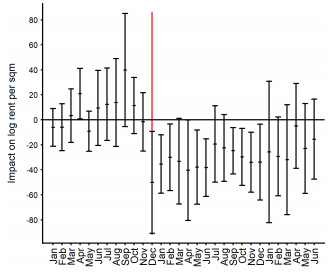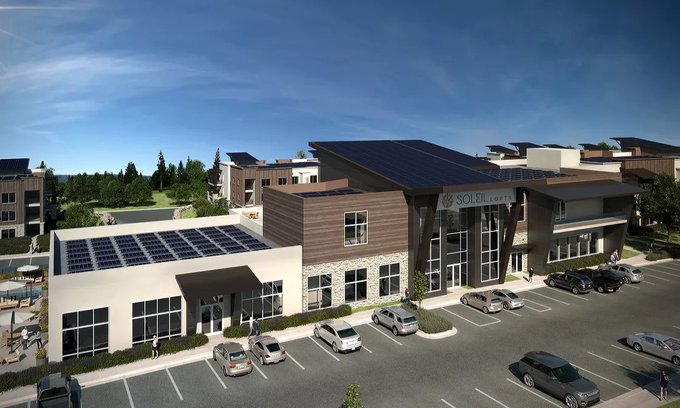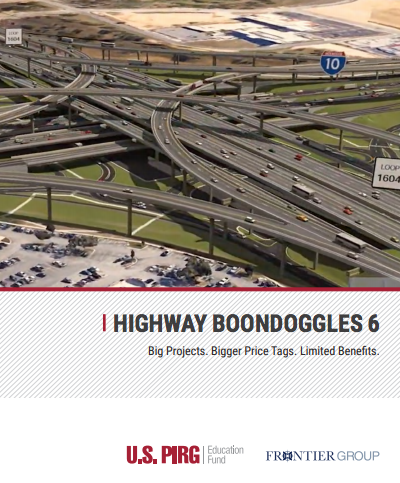What City Observatory did this week
1. Want lower rents? Build more housing! A new study from Germany provides more evidence that the fundamentals of economics are alive and well in the housing market. The study looks at how increments to housing supply affect local rents, and finds that a one percent increase in the number of new homes constructed is associated with a 0.4 to 0.7 percent decrease in rents. Even more importantly, the study finds that rents decline across the board, both in the higher priced and lower priced tiers. A key reason: new market rate construction triggers a chain of moves that ultimately creates vacancies and downward price pressures throughout the market.
The study also provides a quantitative estimate of “how much” new housing is needed to hold rent increases in check. In most German cities, an increase in new construction of between 10 and 20 percent above current levels would push rent inflation to zero.
2. Sustainability is about more than electrification. We’re pleased to publish a guest commentary from Kevin DeGood of the Center for American Progress. In a recent series of tweets, DeGood profiled Soleil, a cutting edge housing development outside Salt Lake City, festooned with solar panels and substantial battery storage.
But the development itself is cut off from the surrounding neighborhoods, and is far from any common non-residential destinations, like shops, cafes and parks. It is car-dependent with a Walk Score of zero and much of the site is given over to roadways and car storage. As DeGood points out, that kind of development simply is not sustainable, no matter how many solar panels it has. Like 1,800 space “LEED certified” parking structures that provide free parking and net zero homes with three car garages, auto dependency is the hallmark of un-sustainability.
Must read
1. What will Post-Covid cities look like? The Atlantic’s Derek Thompson looks at the tea leaves for cities in the wake of the pandemic. We’re all hoping that 2021 will see the widespread distribution of an effective Covid-19 vaccine. Thompson predicts that we’ll see a resurgence in city center office employment, but it will be slowed for a while by our new skill at distance-work. He also predicts that the time we spent at home and in our neighborhoods will lead to a greater interest in promoting “15-minute living.” Most optimistically, Thompson predicts a boom year for economic growth, once we shake off the pandemic: the pent up demand for services and experiences coupled with hundreds of billions of forced savings could fuel a strong economic rebound.
2. More highway boondoggles. Bigger and more wasteful. US PIRG and the Frontier Group have published the sixth volume chronicling wasteful highway projects around the country. On the cover (shown below) is Houston’s Loop 1604 Expansion, which is joined by similarly grandiose and destructive projects in Cincinnati, Birmingham, Chicago, and Charleston, South Carolina. In every case, states are putting hundreds of millions of dollars into roadways which will aggravate air pollution and climate change by encouraging more driving. And as the report notes, due to induced demand, they won’t even achieve their stated objective of lowering traffic congestion.
These projects are the poster children of a highway building complex that at last count squandered $26 billion a year on futile and destructive expansion projects. The report and its accompanying website also has updates on the boondoggles—like the I-5 Rose Quarter Freeway widening in Portland, and is a great resource for tracking freeway fights across the country.
3. Why electric vehicles aren’t a pollution panacea. Many Electric Vehicle (EV) advocates would like you to believe that electric vehicles will somehow cause auto pollution to disappear, but a new analysis by OECD scientists, reported by Kea Wilson at Streetsblog, is a reminder that even “clean” cars create enormous volumes of fine particles, from tire wear and brake linings. These fine particles, including microplastics, are now nearly ubiquitous in the environment and have serious health effects. Recent research from Washington State shows that just one chemical compound in tire residue is responsible for killing adult Coho salmon. Heavy vehicles, driven long distances inevitably produce larger amounts of these kinds of pollutants, even if they’re powered electrically.
4. The perils of bi-partisan agreement on infrastructure. The New York Times editorialized fawningly over the prospects of bipartisan agreement on increased infrastructure spending. But the nostalgia for highway building makes no sense in an era of soaring carbon dioxide levels and a global climate crisis. As Robert Liberty observes, even the illustration chosen for this story reveals the problematic nature of the current glib nods to infrastructure:
It is telling that the photo chosen to accompany this article about consensus politics is a gigantic freeway interchange. This is the symbol of a bi-partisan policy that gutted the cities, enabled white flight into segregated suburban sprawl, polluted the air, changed the climate and destroyed natural resources and the diverse, low-income communities where freeways were built. And little appreciated or understood is that many of these freeway projects were big wastes of money compared to other, smarter projects and that they inevitably failed to fix the congestion that their construction amplified. ‘Bi-partisan” does not equal “good.”
We’ve been down this road before—and it’s why we’re facing a climate crisis. We need a new path, not a repetition of past failures.
New Knowledge
Cities aren’t just about work, they’re about consumption and social interaction, too. The subtext of much of the rumination about the future of cities in a post-Covid world is the notion that, if technology let us work remotely, no one would want to live in a city. Hence predictions that we’ll all decamp to suburbs or rural areas, now that we’ve all figured out how Zoom works.
As we’ve argued at City Observatory, people value living in cities for many reasons, and access to employment is just one. A new study from the London School of Economics looks at the comparative importance of work versus social aspects of cities (consumption and leisure) and comes to a surprising conclusion. Even if all of the productive advantages of urban locations disappeared, their advantages in consumption would still be a powerful force keeping people in cities.
Technically, economists call the benefits of living in dense cities “agglomeration economies” and they come in a couple of different flavors. Agglomeration economies in production stem from labor market pooling, supplier specialization and knowledge spillovers, making workers and firms in cities more productive and profitable. The second, and less studied economic advantage of cities comes from their rich array of consumption opportunities, including the number, diversity and proximity of businesses (like restaurants) and their opportunities for social interaction.
Four economists from LSE— Gabriel Ahlfeldt, Fabian Bald, Duncan Roth, andTobias Seidel—have created a dynamic equilibrium model of urban location to tease out the relative contribution of these two factors. They’ve used this model to perform a kind of post-Covid thought experiment, looking to see what happens to cities under two different alternatives (one where city’s productive advantages are taken away, and a second in which their consumption advantages are erased). It turns out that both of these alternatives reduce the attractiveness of cities to people and businesses, but the effect of losing the social advantages is far more consequential.
More broadly the new method the authors have developed for estimating the value of qualify of life differentials across places suggests that the traditional approach (which assumes frictionless migration, and which doesn’t model divergent and idiosyncratic preferences among population groups) substantially understates the value people attach to quality of life. The implication of this work is that quality of life and local public goods make a considerably larger contribution to well-being that estimated by standard hedonic models. For example: the new method finds that the consumption amenities associated with city size are a bigger factor in increasing welfare (and attracting and holding population) than the production efficiencies of agglomeration.
The authors have a non-technical summary of their work at the LSE US Centre; their full academic paper is available at LSE.
Gabriel M. Ahlfeldt Fabian Bald Duncan Roth Tobias Seidel, “Quality of life in a dynamic spatial model,” Center for Economic Performance Discussion Paper No. 1736, December 2020
In the News
Thanks to StreetsblogLA for highlighting our commentary on how our “free” roads are essentially paying people to drive.




